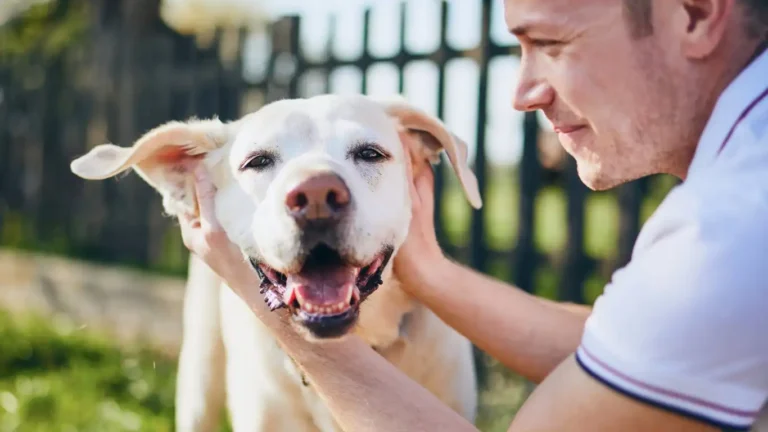How to Prevent & Treat Mange in Dogs: Stop the Itching for Good!
As a pet nutritionist and someone who’s spent years working in veterinary clinics, I’ve seen my fair share of skin issues in dogs. One of the most frustrating (and sadly, common) conditions? Mange. If you’ve ever watched your pup scratch endlessly, losing fur in patches, and looking utterly miserable, you know how heartbreaking it can be. So, let’s dive into how to prevent and treat mange in dogs, so your furry friend can stay happy, healthy, and itch-free.
What Exactly Is Mange in Dogs?

Mange is a skin disease caused by mites that burrow into your dog’s skin, leading to irritation, hair loss, and intense itching. There are two main types:
- Demodectic Mange – Caused by Demodex mites, this form typically affects puppies or dogs with weakened immune systems. It’s not contagious.
- Sarcoptic Mange – Also known as canine scabies, this highly contagious type is caused by Sarcoptes scabiei mites. It spreads between dogs and even to humans.
Both types can cause serious discomfort, and if left untreated, can lead to secondary infections. But don’t worry—I’ll guide you through how to recognize, prevent, and treat it.
Signs and Symptoms of Mange in Dogs

Before you can treat mange, you need to spot the early warning signs. Here’s what to watch for:
- Constant Scratching – If your dog can’t seem to stop scratching, especially at night, it could be mange.
- Red, Inflamed Skin – Mites cause intense irritation, leading to redness, sores, and sometimes even bleeding.
- Patchy Hair Loss – One of the biggest signs is fur falling out in small or large patches.
- Scaly, Crusty Skin – As mange progresses, your dog’s skin might develop scabs or a thickened texture.
- Foul Odor – Severe cases often come with a strong, unpleasant smell due to bacterial infections.
One of the first mange cases I encountered in the clinic was a sweet Golden Retriever named Max. His owners thought he just had allergies, but when I took a closer look, his ears, belly, and legs were covered in crusty patches. A quick skin scrape confirmed Sarcoptic mange. The good news? With the right treatment, Max made a full recovery—and your pup can too.
How to Prevent Mange in Dogs

Prevention is always better than treatment. Here’s how you can keep mange at bay:
1. Maintain a Strong Immune System
Dogs with a healthy immune system are less likely to suffer from mange. Feed your pup a balanced diet rich in omega-3 fatty acids, antioxidants, and high-quality protein. I always recommend fresh, whole foods and the right supplements to keep their skin and coat in top shape.
2. Regular Grooming
Bathing and brushing your dog regularly helps remove dirt, dead skin, and any potential mites before they become a problem. Opt for a mild, hypoallergenic shampoo—especially if your dog has sensitive skin.
3. Keep Their Environment Clean
Mites thrive in dirty bedding and carpets. Wash your dog’s bedding weekly and vacuum your home frequently. If you’ve got multiple pets, make sure they each have their own sleeping space.
4. Avoid Contact with Infected Animals
Since Sarcoptic mange is highly contagious, avoid dog parks or boarding facilities where mange outbreaks have occurred. If your dog plays with others often, do regular skin checks.
5. Use Preventative Treatments
There are prescription topical treatments and oral medications that protect against mites. Talk to your vet about options like selamectin or moxidectin, which can help prevent infestations.
Taking these steps will go a long way in keeping mange from ever becoming an issue. But what if your pup already has it? Don’t worry—I’ve got you covered in the next section.
How to Treat Mange in Dogs

Alright, so your pup has mange—don’t panic! The good news? Mange is treatable. I’ve helped countless dog owners deal with this, and with the right approach, your furry friend will be back to normal in no time.
The treatment plan depends on whether your dog has demodectic mange or sarcoptic mange. But no matter which type, the key is consistency. You’ll need a combination of medicated baths, prescription treatments, home remedies, and proper care to kick mange to the curb.
1. Medicated Baths
One of the first steps in treating mange is giving your dog a medicated bath. This helps kill mites on the surface and soothes irritated skin.
- Benzoyl Peroxide Shampoo – This deep-cleansing shampoo helps open hair follicles and remove dead skin. It’s often used for demodectic mange.
- Lime Sulfur Dip – This stinky (but effective) treatment kills mites on contact. I’ve seen it work wonders on sarcoptic mange cases.
- Aloe Vera or Oatmeal-Based Shampoos – These can help relieve itching and inflammation.
When bathing your dog, make sure to lather them up thoroughly and let the shampoo sit for at least 10-15 minutes before rinsing. It might take multiple baths over several weeks to see improvement.
2. Prescription Medications
For severe cases, your vet may prescribe oral or topical treatments. I always recommend following a vet’s advice because mange can quickly escalate if not treated properly.
- Isoxazoline-Based Medications – Drugs like Bravecto, NexGard, and Simparica are highly effective in killing mites.
- Ivermectin – Often used off-label for demodectic mange, though it’s not safe for certain breeds like Collies.
- Selamectin (Revolution) – A spot-on treatment that works well against sarcoptic mange.
My personal favorite? Bravecto. I’ve seen dogs with severe mange transform within weeks using this medication. It’s a game-changer.
3. Home Remedies for Mange

While prescription treatments are the gold standard, some home remedies can help soothe your dog’s skin and support healing.
- Coconut Oil – Has natural antibacterial and antifungal properties. Massage it into affected areas for relief.
- Apple Cider Vinegar – A diluted solution (50/50 with water) can help disinfect the skin and reduce itching.
- Aloe Vera – A cooling, natural anti-inflammatory that helps repair damaged skin.
- Turmeric Paste – Mixed with coconut oil, this can help with inflammation and skin healing.
Just remember—home remedies alone won’t cure mange, but they can be a great supportive treatment alongside medicated baths and prescriptions.
Supporting Your Dog’s Recovery

Treating mange isn’t just about killing the mites—you need to help your dog’s body heal and rebuild. Here’s how:
1. Strengthen the Immune System
Dogs with strong immune systems recover faster. Focus on a high-quality diet with lean proteins, omega fatty acids, and antioxidants. Some great options include:
- Salmon and sardines – Rich in omega-3s to support skin healing.
- Pumpkin and sweet potatoes – Great sources of vitamins A and C for immunity.
- Bone broth – Helps repair damaged skin and promotes hydration.
2. Keep Their Skin Hydrated
Dry, flaky skin can slow recovery. Consider adding a fish oil supplement or coconut oil to their food for extra skin nourishment.
3. Prevent Secondary Infections
Mange often leads to open sores, which can get infected. Keep an eye out for signs of infection like swelling, pus, or a bad odor. If you notice any of these, your vet may prescribe antibiotics.
4. Maintain a Clean Environment
Even if the mites are gone, you don’t want them coming back. Make sure to:
- Wash your dog’s bedding, collars, and toys weekly.
- Vacuum carpets and furniture regularly.
- Disinfect common areas where your dog spends time.
One of my clients had a rescue pup named Daisy who struggled with recurring mange because her bedding wasn’t being cleaned often enough. Once they started washing everything weekly, Daisy finally recovered fully. Little details like this make a huge difference!
With the right treatment plan and a little patience, your dog can bounce back from mange and live a happy, itch-free life. In the next section, we’ll dive into how to stop mange from ever coming back.
How to Prevent Mange from Coming Back

After all the hard work you’ve put into treating mange, the last thing you want is a relapse. Trust me, I’ve seen too many cases where a dog recovers, only to get reinfected weeks later because prevention steps weren’t followed. Here’s how to make sure that doesn’t happen.
1. Stick to a Regular Parasite Prevention Routine
The best way to keep mange at bay? Monthly flea and mite preventatives. Your vet can recommend the best options, but some of the most effective ones include:
- Bravecto – Protects against mites, fleas, and ticks for up to 3 months.
- Revolution (Selamectin) – A topical treatment that helps prevent sarcoptic mange.
- NexGard – A chewable tablet that targets parasites before they can cause problems.
Many dog owners assume these preventatives are only for fleas and ticks, but they also help protect against mange mites. It’s an easy, once-a-month habit that can save you a lot of trouble down the road.
2. Maintain a Clean Living Environment
Mange mites can linger in your dog’s surroundings, so keeping everything clean is essential. Here’s what I always tell dog owners:
- Wash all bedding, blankets, and soft toys in hot water at least once a week.
- Vacuum and disinfect carpets, furniture, and dog crates regularly.
- If your dog had sarcoptic mange, consider using a pet-safe household spray to eliminate any lingering mites.
One of my clients had a German Shepherd named Luna who kept getting mange over and over. Turns out, her favorite nap spot—a cozy old rug—was the culprit. Once they replaced it and started washing her bedding weekly, the problem finally stopped.
3. Boost Your Dog’s Skin & Coat Health
Healthy skin is your dog’s first line of defense against mange. A strong immune system can help prevent flare-ups, even if your dog comes into contact with mites. Here’s what I recommend:
- Fish Oil or Omega-3 Supplements – Helps reduce inflammation and strengthen skin.
- Probiotics – Supports gut health, which in turn helps the immune system fight off infections.
- A Balanced Diet – High-protein foods and fresh veggies provide essential nutrients.
If your dog is prone to skin issues, talk to your vet about adding a skin-supporting supplement to their diet.
When to See a Vet for Mange

While mild cases of mange can sometimes be managed at home, there are times when you’ll need professional help. Here’s when you should book a vet visit:
- Severe Hair Loss or Open Wounds – If your dog’s skin is raw or bleeding, secondary infections may have set in.
- No Improvement After Two Weeks – If you’ve started treatment but your dog’s condition isn’t getting better, it’s time for a check-up.
- Extreme Itching & Restlessness – Constant scratching, especially at night, could mean a more aggressive case of mange.
- Other Pets or Humans Showing Symptoms – Since sarcoptic mange is contagious, if anyone else in the household starts itching, you’ll need to address it fast.
Your vet might perform a skin scraping to confirm the presence of mites and prescribe a stronger treatment plan if needed. In some cases, injectable medications or antibiotics for secondary infections may be necessary.
Final Thoughts
Mange in dogs is tough to deal with, but with the right approach, you can eliminate it and prevent it from coming back. From my experience, the key is early detection, consistent treatment, and long-term prevention. Don’t wait until your pup is miserable—if you spot the signs, take action immediately.
And remember, you’re not alone in this! Many pet parents have gone through the same struggle, and their dogs have come out the other side healthier and happier. Stay patient, follow through with treatment, and your furry friend will be back to their playful self in no time.
References
Disclaimer
This article is for informational purposes only and should not replace professional veterinary advice. If your dog is showing signs of mange or any other skin condition, consult a licensed veterinarian for an accurate diagnosis and treatment plan.






